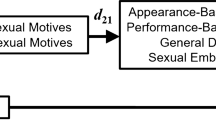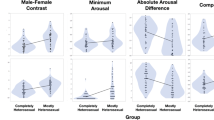Abstract
Little is known about non-monosexual women’s sexual arousal and desire. Typically, bisexual women have been excluded from research on sexual arousal and desire, whereas mostly heterosexual and mostly lesbian women have been placed into monosexual categories. This research (1) compared the subjective sexual arousal and desire of self-identified heterosexual, mostly heterosexual, bisexual, mostly lesbian, and lesbian women in partnered sexual activities with men and with women, and (2) compared within-group differences for subjective sexual arousal and desire with men versus women for the five groups. Participants included 388 women (M age = 24.40, SD = 6.40, 188 heterosexual, 53 mostly heterosexual, 64 bisexual, 32 mostly lesbian, 51 lesbian) who filled out the Sexual Arousal and Desire Inventory (SADI). Sexual orientation was associated with sexual arousal and desire in sexual activities with both men and with women. Bisexuals reported higher sexual arousal and desire for women than heterosexuals and lesbians, while lesbians reported lower sexual arousal and desire with men than the other groups. Heterosexuals and mostly heterosexuals scored higher on the male than on the female motivational dimension of the SADI, while the reverse was found for lesbians and mostly lesbians. Findings indicate that non-monosexuals have higher sexual arousal and desire in sexual activities with women than monosexuals. Further, bisexual women did not differentiate their sexual arousal with men versus women, while the other sexual orientation groups differentiated in terms of their motivation to engage in sexual activity. These findings may have implications for how female sexual orientation is conceptualized.



Similar content being viewed by others
References
Bailey, J. M. (2009). What is sexual orientation and do women have one? In D. A. Hope (Ed.), Contemporary perspectives on lesbian, gay, and bisexual identities (Vol. 54, pp. 43–63). New York, NY: Springer.
Bailey, J. M., Rieger, G., & Rosenthal, A. (2011). Still in search of bisexual sexual arousal: Comment on Cerny and Janssen (2011). Archives of Sexual Behavior, 40(6), 1293–1295. doi:10.1007/s10508-011-9778-5.
Baumeister, R. F. (2000). Gender differences in erotic plasticity: The female sex drive as socially flexible and responsive. Psychological Bulletin, 126(3), 347–374.
Beach, F. A. (1976). Sexual attractivity, proceptivity, and receptivity in female mammals. Hormones and Behavior, 7(1), 105–138. doi:10.1016/0018-506X(76)90008-8.
Bossio, J. A., Suschinsky, K. D., Puts, D. A., & Chivers, M. L. (2014). Does menstrual cycle phase influence the gender specificity of heterosexual women’s genital and subjective sexual arousal? Archives of Sexual Behavior, 43, 941–952. doi:10.1007/s10508-013-0233-7.
Chivers, M. L. (2010). A brief update on the specificity of sexual arousal. Sexual and Relationship Therapy, 25(4), 407–414. doi:10.1080/14681994.2010.495979.
Chivers, M. L., & Bailey, J. M. (2005). A sex difference in features that elicit genital response. Biological Psychology, 70(2), 115–120. doi:10.1016/j.biopsycho.2004.12.002.
Chivers, M. L., & Bailey, J. M. (2007). The sexual psychophysiology of sexual orientation. In E. Janssen (Ed.), The psychophysiology of sex (pp. 458–474). Bloomington, IN: Indiana University Press.
Chivers, M. L., Rieger, G., Latty, E., & Bailey, J. M. (2004). A sex difference in the specificity of sexual arousal. Psychological Science, 15(11), 736–744. doi:10.1111/j.0956-7976.2004.00750.x.
Chivers, M. L., Seto, M. C., & Blanchard, R. (2007). Gender and sexual orientation differences in sexual response to sexual activities versus gender of actors in sexual films. Journal of Personality and Social Psychology, 93(6), 1108–1121. doi:10.1037/0022-3514.93.6.1108.
Chivers, M. L., Seto, M. C., Lalumière, M., Laan, E., & Grimbos, T. (2010). Agreement of self-reported and genital measures of sexual arousal in men and women: A meta-analysis. Archives of Sexual Behavior, 39(1), 5–56. doi:10.1007/s10508-009-9556-9.
Chivers, M. L., & Timmers, A. D. (2012). Effects of gender and relationship context in audio narratives on genital and subjective sexual response in heterosexual women and men. Archives of Sexual Behavior, 41(1), 185–197. doi:10.1007/s10508-012-9937-3.
Diamond, L. M. (1998). Development of sexual orientation among adolescent and young adult women. Developmental Psychology, 34(5), 1085–1095. doi:10.1037/0012-1649.34.5.1085.
Diamond, L. M. (2000). Sexual identity, attractions, and behavior among young sexual minority women over a 2-year period. Developmental Psychology, 36(2), 241–250. doi:10.1037/0012-1649.36.2.241.
Diamond, L. M. (2003a). Was it a phase? Young women’s relinquishment of lesbian/bisexual identities over a 5-year period. Journal of Personality and Social Psychology, 84(2), 352–364. doi:10.1037/0022-3514.84.2.352.
Diamond, L. M. (2003b). What does sexual orientation orient? A biobehavioral model distinguishing romantic love and sexual desire. Psychological Review, 110(1), 173–192. doi:10.1037/0033-295x.110.1.173.
Diamond, L. M. (2005). A new view of lesbian subtypes: Stable versus fluid identity trajectories over an 8-year period. Psychology of Women Quarterly, 29(2), 119–128. doi:10.1111/j.1471-6402.2005.00174.x.
Diamond, L. M. (2007). The evolution of plasticity in female-female desire. Journal of Psychology and Human Sexuality, 18, 245–274. doi:10.1300/J056v18n04_01.
Diamond, L. M. (2008a). Female bisexuality from adolescence to adulthood: Results from a 10-year longitudinal study. Developmental Psychology, 44(1), 5–14. doi:10.1037/0012-1649.44.1.5.
Diamond, L. M. (2008b). Sexual fluidity: Understanding women’s love and desire. Cambridge, MA: Harvard University Press.
Diamond, L. M., & Wallen, K. (2011). Sexual minority women’s sexual motivation around the time of ovulation. Archives of Sexual Behavior, 40, 237–246. doi:10.1007/s10508-010-9631-2.
Ebsworth, M., & Lalumière, M. L. (2012). Viewing time as a measure of bisexual sexual interest. Archives of Sexual Behavior, 41(1), 161–172. doi:10.1007/s10508-012-9923-9.
Goldey, K. L., & van Anders, S. M. (2012). Sexual arousal and desire: Interrelations and responses to three modalities of sexual stimuli. Journal of Sexual Medicine, 9(9), 2315–2329. doi:10.1111/j.1743-6109.2012.02845.x.
Hequembourg, A. L., Livingston, J. A., & Parks, K. A. (2013). Sexual victimization and associated risks among lesbian and bisexual women. Violence Against Women, 19(5), 634–657. doi:10.1177/1077801213490557.
Israel, E., & Strassberg, D. (2009). Viewing time as an objective measure of sexual interest in heterosexual men and women. Archives of Sexual Behavior, 38(4), 551–558. doi:10.1007/s10508-007-9246-4.
Israel, T., & Mohr, J. J. (2004). Attitudes toward bisexual women and men: Current research, future directions. In R. C. Fox (Ed.), Current research on bisexuality (pp. 117–134). Binghamton, NY: Harrington Park Press/The Haworth Press.
Johnson, A. M., Wadsworth, J., Wellings, K., & Field, J. (1994). The National Survey of Sexual Attitudes and Lifestyles. Oxford: Blackwell Scientific Press.
Laan, E., Sonderman, M., & Janssen, E. (1995). Straight and lesbian women’s sexual responses to straight and lesbian erotica: No sexual orientation effects. Poster presented at the meeting of the International Academy of Sex Research, Provincetown, MA.
Laumann, E. O., Gagnon, J. H., Michael, R. T., & Michaels, S. (1994). The social organization of sexuality: Sexual practices in the United States. Chicago, IL: University of Chicago Press.
Lehavot, K., Molina, Y., & Simoni, J. (2012). Childhood trauma, adult sexual assault, and adult gender expression among lesbian and bisexual women. Sex Roles, 67(5–6), 272–284. doi:10.1007/s11199-012-0171-1.
Lhomond, B., Saurel-Cubizolles, M.-J. P., Michaels, S., & The CSF Group. (2014). A multidimensional measure of sexual orientation, use of psychoactive substances, and depression: Results of a national survey on sexual behavior in France. Archives of Sexual Behavior, 43, 607–619. doi:10.1007/s10508-013-0124-y.
Lippa, R. A. (2006). Is high sex drive associated with increased sexual attraction to both sexes? It depends on whether you are male or female. Psychological Science, 17(1), 46–52. doi:10.1111/j.1467-9280.2005.01663.x.
Lippa, R. A. (2007). The relation between sex drive and sexual attraction to men and women: A cross-national study of heterosexual, bisexual, and homosexual men and women. Archives of Sexual Behavior, 36(2), 209–222. doi:10.1007/s10508-006-9146-z.
Lippa, R. A. (2013). Men and women with bisexual identities show bisexual patterns of sexual attraction to male and female ‘swimsuit models’. Archives of Sexual Behavior, 42(2), 187–196. doi:10.1007/s10508-012-9981-z.
Mercer, C. H., Tanton, C., Prah, P., Erens, B., Sonnenberg, P., Clifton, S., … Johnson, A. M. (2013). Changes in sexual attitudes and lifestyles in Britain through the life course and over time: Findings from the National Surveys of Sexual Attitudes and Lifestyles (Natsal). Lancet, 382(9907), 1781–1794. doi:10.1016/S0140-6736(13)62035-8.
Mustanski, B. S., Chivers, M. L., & Bailey, J. M. (2002). A critical review of recent biological research on human sexual orientation. Annual Review of Sex Research, 13, 89–140.
Rieger, G., Rosenthal, A. M., Cash, B. M., Linsenmeier, J. A. W., Bailey, J. M., & Savin-Williams, R. C. (2013). Male bisexual arousal: A matter of curiosity? Biological Psychology, 94(3), 479–489. doi:10.1016/j.biopsycho.2013.09.007.
Rosenthal, A. M., Sylva, D., Safron, A., & Bailey, J. M. (2012). The male bisexuality debate revisited: Some bisexual men have bisexual arousal patterns. Archives of Sexual Behavior, 41(1), 135–147. doi:10.1007/s10508-011-9881-7.
Rullo, J., Strassberg, D., & Israel, E. (2010). Category-specificity in sexual interest in gay men and lesbians. Archives of Sexual Behavior, 39(4), 874–879. doi:10.1007/s10508-009-9497-3.
Rust, P. C. (1992). The politics of sexual identity: Sexual attraction and behavior among lesbian and bisexual women. Social Problems, 39(4), 366–386.
Rust, P. C. (1995). Bisexuality and the challenge to lesbian politics: Sex, loyalty, and revolution. New York, NY: New York University Press.
Rust, P. C. (2000). Bisexuality: A comtemporary paradox for women. Journal of Social Issues, 56, 205–221. doi:10.1111/0022-4537.00161.
Savin-Williams, R. C. (2006). Who’s gay? Does it matter? Current Directions in Psychological Science, 15(1), 40–44. doi:10.1111/j.0963-7214.2006.00403.x.
Savin-Williams, R. C. (2009). How many gays are there? It depends. In D. A. Hope (Ed.), Contemporary perspectives on lesbian, gay, and bisexual identities (vol. 54, pp. 5–41): New York, NY: Springer.
Savin-Williams, R. C., & Vrangalova, Z. (2013). Mostly heterosexual as a distinct sexual orientation group: A systematic review of the empirical evidence. Developmental Review, 33(1), 58–88. doi:10.1016/j.dr.2013.01.001.
Schmitt, D. P. (2005). Sociosexuality from Argentina to Zimbabwe: A 48-nation study of sex, culture, and strategies of human mating. Behavioral and Brain Sciences, 28(2), 247–311. doi:10.1017/S0140525X05000051.
Shively, M. G., & De Cecco, J. P. (1977). Components of sexual identity. Journal of Homosexuality, 3(1), 41–48. doi:10.1300/J082v03n01_04.
Storms, M. D. (1980). Theories of sexual orientation. Journal of Personality and Social Psychology, 38, 783–792. doi:10.1037/0022-3514.38.5.783.
Suschinsky, K. D., Bossio, J. A., & Chivers, M. L. (2014). Women’s genital sexual arousal to oral versus penetrative heterosexual sex varies with menstrual cycle phase at first exposure. Hormones and Behavior, 65(3), 319–327. doi:10.1016/j.yhbeh.2014.01.006.
Suschinsky, K. D., & Lalumière, M. (2012). Is sexual concordance related to awareness of physiological states? Archives of Sexual Behavior, 41(1), 199–208. doi:10.1007/s10508-012-9931-9.
Suschinsky, K. D., Lalumière, M. L., & Chivers, M. L. (2009). Sex differences in patterns of genital sexual arousal: Measurement artifacts or true phenomena? Archives of Sexual Behavior, 38(4), 559–573. doi:10.1007/s10508-008-9339-8.
Toledano, R., & Pfaus, J. (2006). The Sexual Arousal and Desire Inventory (SADI): A multidimensional scale to assess subjective sexual arousal and desire. Journal of Sexual Medicine, 3(5), 853–877. doi:10.1111/j.1743-6109.2006.00293.x.
van Anders, S. (2012). From one bioscientist to another: Guidelines for researching and writing about bisexuality for the lab and biosciences. Journal of Bisexuality, 12(3), 393–403. doi:10.1080/15299716.2012.702621.
Vrangalova, Z., & Savin-Williams, R. C. (2012). Mostly heterosexual and mostly gay/lesbian: Evidence for new sexual orientation identities. Archives of Sexual Behavior, 41, 85–101. doi:10.1007/s10508-012-9921-y.
Acknowledgments
TJP was supported by a doctoral scholarship from the Canadian Institutes of Health Research.
Author information
Authors and Affiliations
Corresponding author
Rights and permissions
About this article
Cite this article
Persson, T.J., Ryder, A.G. & Pfaus, J.G. Comparing Subjective Ratings of Sexual Arousal and Desire in Partnered Sexual Activities from Women of Different Sexual Orientations. Arch Sex Behav 45, 1391–1402 (2016). https://doi.org/10.1007/s10508-014-0468-y
Received:
Revised:
Accepted:
Published:
Issue Date:
DOI: https://doi.org/10.1007/s10508-014-0468-y




